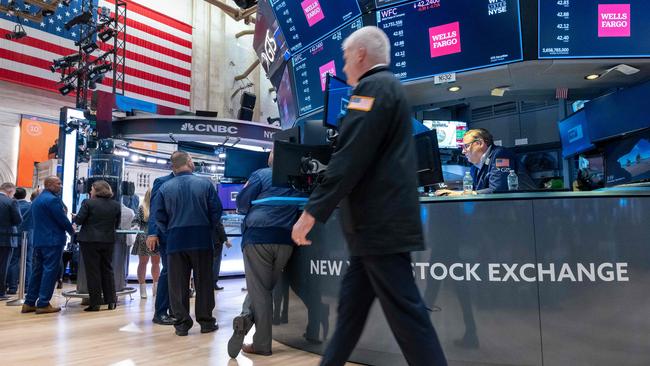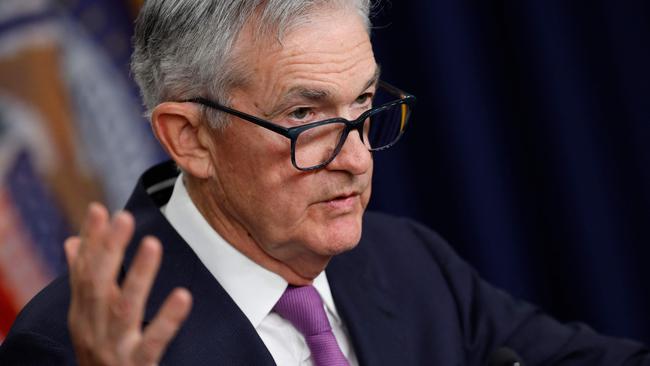Higher-for-longer US rates imposes a reality check on sharemarkets
September is living up to its reputation as a bad month for shares as economic resilience and sticky inflation fuels a rise in bond yields and the US Fed hardens its position on rates.

September is living up to its reputation as a bad month for shares as US economic resilience and sticky inflation fuels a relentless rise in bond yields and the Fed looks set to keep rates higher for longer.
After surging 32 per cent from its October 2022 low to its July 2023 peak – as the AI boom showed promise and falling inflation led the money market to expect a string of US interest rate cuts in 2024 – the S&P 500 fell as much as 6.6 per cent to Monday’s low, hitting its lowest point since early June.
The US sharemarket’s worst week since the US regional banking crisis in March came as the benchmark US 10-year bond yield soared to 16-year highs above 4.5 per cent, despite a consensus view that bonds were good buying after the yield hit 4.34 per cent last October and inflation fell.
A global sell-off in shares looked set to continue as S&P 500 futures fell 0.8 per cent in Tuesday’s Asia-Pacific trading and Australia’s S&P/ASX 200 share index fell 0.5 per cent to its lowest daily close in the past two months. It came as the US 10-year bond yield hit a post-2007 high of 4.569 per cent.
As of Monday, the US money market was pricing in 77 basis points of rate cuts by the Fed in 2024, down from 117 basis points at the start of the month, and it implied a 50 per cent chance of an additional 25 basis point lift in the Fed funds rate to 5.5-5.75 per cent, its highest level since 2001.
Rapid disinflation and economic resilience appeared to support the “Goldilocks” narrative up until the FOMC meeting last Thursday when its interest rate expectations were raised significantly.
The median estimate of the Fed funds rate rose 50 basis points for 2024 and 2025 and the FOMC’s first estimate for 2026 was 2.875 per cent. Moreover, while the long-run estimate remained at 2.5 per cent, Federal Reserve chair Jerome Powell said it was “plausible the neutral rate is higher than the long-run rate”.

US economic growth forecasts were lifted slightly, but core PCE inflation forecasts were revised up slightly and the Fed’s preferred inflation gauge was projected to be above target until 2026.
The problem for the US sharemarket remains that in the absence of a recession – which would be particularly bad for cyclical equities – the Fed may not cut rates as much as expected unless inflation falls faster than expected, yet that isn’t guaranteed without a recession.
With the S&P 500 forming a significant downtrend last Thursday and the correlation between equity prices and bond yields turning negative again, a September/October reality check is now under way.
Good news on the US economy may once again be viewed as bad news for shares because of the interest rate implications. And sticky inflation concerns will be at the forefront of concerns, particularly in Europe and Britain, but possibly also in the US, Canada and Australia.
JPMorgan strategists say the message received from developed market central banks last week was that policy rates will need to remain “high for long” relative to market expectations.
That aligns with their economist’s “boiling the frog” view, where economic resilience promotes sticky inflation and a need for sustained restrictive policy stances, which in turn, compresses profit margins, erodes balance sheet health, and brings an end to the expansion.
“Instead of getting hurt from higher input costs, most companies benefited over the past two years, due to better mix and stronger pricing; however, this dynamic is at risk of reversal,” said the US investment bank’s chief market strategist and co-head of global research, Marko Kolanovic. He says timing the point at which building vulnerabilities spark an end to the expansion is “difficult”.
But while the focus remains on the prospect of interest rates being high or higher for longer than expected, the sharemarket may have a further reality check on the outlook for profit margins, balance sheet health and the economic outlook.
Lower than expected inflation data are needed.
BlackRock Investment Institute head Jean Boivin says the market is adjusting to a new regime of higher macroeconomic volatility after the pandemic.
He’s not ready to jump back into long-term US Treasuries, despite a massive rise in the US 10-year bond yield from around 3.75 per cent to 4.55 per cent since mid-July.
Mr Boivin warns that a rising “term premium” – the compensation investors seek to hold long-term bonds – can push yields higher still, as can quantitative tightening and the step-up in Treasury issuance in recent months. That would surely be taken badly by the sharemarket at this point.
“Our long-held underweight to long-term US Treasuries has served us well as yields climb,” he said.
“Markets have come around to our view on policy rates. Yet there is still little term premium.”
It came as Moody’s warned a potential US government shutdown would underscore the weakness of US institutional and governance strength relative to other Aaa-rated sovereigns.
It would also demonstrate the significant constraints that intensifying political polarisation continue to put on US fiscal policy making during a period of declining fiscal strength, driven by persistent fiscal deficits and deteriorating debt affordability, Moody’s said.



